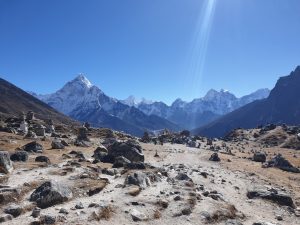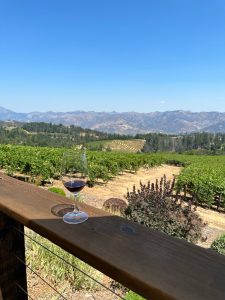Nepal is a photographer’s paradise. From soaring snow-capped peaks to ancient temples, lush valleys to vibrant festivals, this Himalayan country offers a rich and diverse canvas for photography.
Whether you’re a professional with a DSLR or a traveler with a smartphone, the landscapes, culture, and people of Nepal provide endless opportunities to tell visual stories.
In this guide, we explore the best photographic spots in Nepal—places that combine breathtaking views, cultural richness, and natural beauty. Each location is ideal for capturing Instagram-worthy shots, portfolio-defining images, or simply timeless memories.
1. Kala Patthar – Best View of Mount Everest
Situated at 5,545 meters, Kala Patthar is the most popular viewpoint on the Everest Base Camp Trek, and arguably the best place to photograph Mount Everest. The panoramic view includes Everest, Lhotse, Nuptse, and the massive Khumbu Glacier below.
Photographers usually hike up before dawn to catch the golden sunrise over Everest, with glowing peaks and dramatic shadows. The light is soft and pure, perfect for wide-angle landscape shots and panoramic vistas. A tripod is highly recommended due to the low temperatures and light conditions.
2. Poon Hill – Annapurna Sunrise
Poon Hill (3,210 m) near Ghorepani is a must for any landscape photographer. It’s known for its incredible sunrise views over the Annapurna and Dhaulagiri ranges. Trekkers often rise early to hike to the viewpoint before dawn.
In December and spring, snow adds a magical contrast to the golden tones of the sunrise. The silhouettes of layered hills and sharp peaks create dreamy, multi-dimensional images. It’s also an easier trek, making it a great destination for amateur photographers.
3. Pokhara – Lakeside Beauty and Mountain Reflections
The tranquil city of Pokhara offers diverse photography subjects: mirror-like reflections of Machapuchare (Fishtail Mountain) on Phewa Lake, colorful boats, sunrise from Sarangkot, and cascading waterfalls like Devi’s Fall.
The city lights up at night and offers cityscapes with Himalayan backdrops. It’s also an ideal place to practice drone photography, with wide open valleys and unobstructed skylines.
4. Bhaktapur Durbar Square – Living History
Bhaktapur, one of the three medieval cities of the Kathmandu Valley, is an architectural gem. Red brick temples, wooden carvings, narrow alleys, and traditional potters working in open courtyards create a timeless urban photography experience.
Golden hour brings warm hues to the Newari architecture, and local festivals add movement, color, and emotion to your shots. Bhaktapur is a UNESCO World Heritage Site and a true photographer’s dream.
5. Gokyo Ri – Lakes and Everest Panorama
Located along the Everest Base Camp trek via Gokyo Lake, Gokyo Ri (5,357 m) offers a lesser-known but stunning alternative to Kala Patthar. From the top, you can capture Gokyo Lakes, Cho Oyu, Makalu, Everest, and the Ngozumpa Glacier.
The deep blue lakes against snow-capped peaks are especially photogenic during early morning light. The entire Gokyo Valley is ideal for capturing reflections, icy textures, and vast Himalayan landscapes.
6. Upper Mustang – Desert Landscapes and Tibetan Culture
Photographing Upper Mustang is like stepping into another world. The arid landscapes, red cliffs, ancient cave dwellings, and walled city of Lo Manthang offer a rich tapestry of natural and cultural subjects.
This region is influenced by Tibetan Buddhism, with colorful monasteries, prayer flags, and dramatic festivals. The soft light of late afternoon enhances the earthy tones of Mustang’s canyons and fortresses.
7. Tilicho Lake – High-Altitude Serenity
Tilicho Lake (4,919 m), part of the Annapurna Circuit Trek, is one of the world’s highest lakes and a surreal location for photography. Its icy blue surface reflects Tilicho Peak, and the rugged surroundings provide powerful contrast.
Sunrise and sunset offer intense hues, while mid-day light enhances the clarity of the water. Due to its remote location, you’ll likely be alone here, adding to the purity of your shots.
8. Boudhanath Stupa – Spiritual Symmetry
Boudhanath, one of the largest Buddhist stupas in the world, is a visual feast of symmetry, prayer flags, spinning wheels, and serene rituals. Early morning or twilight is the best time to capture monks walking clockwise around the stupa and locals lighting butter lamps.
The golden spire, white dome, and surrounding Tibetan shops offer unique compositions. It’s also a great spot for low-light photography and street portraits.
9. Chitwan National Park – Wildlife Photography
For wildlife enthusiasts, Chitwan National Park offers opportunities to photograph rhinos, elephants, crocodiles, deer, and—if you’re lucky—even a Bengal tiger. Safari jeeps, canoes, and elephant rides offer access to different terrains.
The jungle is especially photogenic in the soft morning light and fog. Use a zoom lens for safe and sharp wildlife captures. Bird photographers will also love Chitwan, with over 500 bird species present.
10. Rara Lake – Remote Mountain Paradise
In the far northwest of Nepal, Rara Lake is remote, quiet, and breathtakingly beautiful. It’s surrounded by pine forests and alpine meadows, with snow-capped peaks rising in the background.
This location offers stunning reflection shots, and drone photography reveals the lake’s emerald color and teardrop shape. It’s best visited in autumn or spring when skies are clearest.
11. Nagarkot – Sunrise over the Himalayas
Just an hour from Kathmandu, Nagarkot is a hill station famous for panoramic views of the Himalayas. On clear days, you can photograph Mount Everest, Manaslu, Langtang, and even Kanchenjunga from here.
Sunrise and sunset bring changing colors, misty silhouettes, and golden light over terraced hills. It’s easily accessible and ideal for beginner photographers and those short on time.
12. Patan Durbar Square – Heritage and Humanity
Patan, or Lalitpur, blends ancient architecture with a vibrant city lifestyle. The intricately carved temples, traditional artisans, and daily life scenes make it perfect for street and documentary photography.
Patan’s golden hour is especially rewarding, and many photographers love shooting the reflections after rain, creating a moody, historical ambiance.
Tips for Trekking Photographers
- Start early: Morning light is best, especially for Himalayan views.
- Carry extra batteries: Especially for remote treks like Annapurna Base Camp where electricity is limited.
- Use lens filters: Polarizers enhance skies and water.
- Pack light: Consider a versatile lens (18-135mm or 24-105mm).
- Respect local customs: Always ask before photographing people.
Final Thoughts
From sacred stupas to snow-covered summits, Nepal offers some of the most visually captivating experiences in the world. Each region has its unique flavor, and every trail reveals hidden gems for your camera to capture.
Whether you’re chasing golden light on Everest, photographing ancient rituals in Bhaktapur, or framing reflections in Pokhara, Nepal is a never-ending canvas for your lens. Bring your gear, your curiosity, and your eye for wonder—this Himalayan country will reward you at every click.










